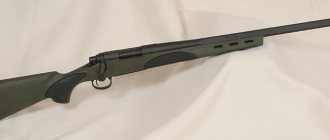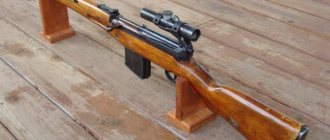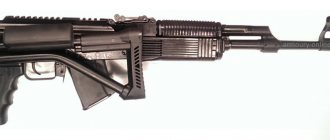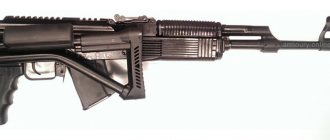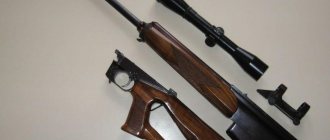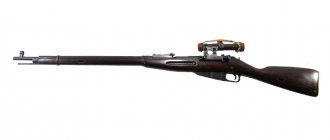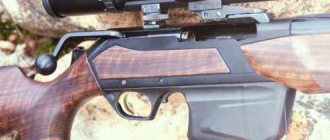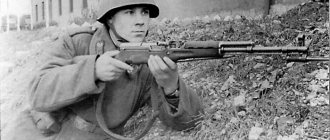This term has other meanings, see SM-2 (meanings).
| SM-2 | |
| Type | small-bore sporting rifle |
| A country | USSR |
| Production history | |
| Designed by | 1963 |
| Manufacturer | Izhmash |
| Characteristics | |
| Weight, kg | 5,0 |
| Length, mm | 1110 |
| Barrel length, mm | 680 |
| Width, mm | 80 |
| Height, mm | 225 |
| Cartridge | .22 LR |
| Caliber, mm | 5,6 |
| Work principles | sliding valve |
SM-2
- single-shot standard small-caliber rifle produced by the Izhevsk Machine-Building Plant. It belongs to the class of sports training rifles, is intended for training discharge athletes and occupies an intermediate position between the TOZ-8M sports rifle and high-class target rifles. Due to its simple design and low weight, it is recommended for beginner athletes, women and juniors. It has high accuracy and stability of combat, is equipped with a replaceable diopter sight and a set of replaceable front sights with ring-shaped earpieces.
For shooting, target or sport-hunting .22 LR rimfire cartridges of 5.6 mm caliber are used.
The SM-2 rifle served as the basis for the creation of the SM-2KO hunting carbine and the SM-3 standard rifle.
Description of the SM-2KO carbine
The carbine is chambered for the .22LR rimfire cartridge. The shutter is longitudinally sliding. The barrel is thick-walled, match-grade, with a funnel-shaped chamfer on the muzzle.
The transition from the category of a sporting weapon to a hunting weapon was accompanied by the construction of a magazine shaft, a change in the ergonomics of the stock and the installation of two longitudinal grooves on the upper edge of the receiver, forming a kind of dovetail strip.
An overview of the SM-2KO small-caliber rifle is given in this video:
Advantages and disadvantages
A very simple design in which there is simply nothing to break.
- A barrel with good internal ballistics, allowing you to confidently hit targets at distances of up to 100 meters. However, it is worth noting that the .22LR bullet has a low muzzle velocity, resulting in a ballistic trajectory. In addition, it is highly susceptible to the influence of wind. Therefore, this ammunition is more suitable for sports or training shooting at a shooting range. In field conditions, a distance of 50 meters can be considered the maximum.
- The bolt has no lugs. This simplifies the design and makes reloading easier - there are fewer reasons for jamming in the grooves. However, among small-caliber fans there is no consensus on the sufficiency of locking only by placing the handle in the groove of the receiver. For example, on the bolts of the CZ-452 rifles there are as many as three lugs, which is clearly excessive. It seems that a disdainful attitude towards “toy” ammunition is also not the right train of thought.
- The bolt is removed from the receiver after pressing the trigger, much the same as with a Mosin rifle. Therefore, its loss during long transitions is not excluded. The high probability of such an event has been proven by practical cases with Red Army soldiers, the most experienced of whom preferred to keep this part of the rifle in their pocket.
- The force on the trigger is not adjustable, it is always the same, about a kilogram. Whether this is considered a disadvantage or an advantage is a personal matter for each shooter. But you can adjust the stroke length in the range from 2 to 4 mm, which allows the shooter to customize the weapon in accordance with his temperament or the nature of the hunt.
- The grooves that form the dovetail strip are not the most optimal solution for mounting optical instruments. If the sight is too massive, it will not hold properly.
- The carbine's magazine is made of plastic, which is a fashionable modern trend, but is not supported by most adherents of the classic weapon design of metal and wood. In addition, it dangles in the shaft and to eliminate this incident you have to wrap it up with electrical tape. The magazine capacity of 10 rounds is clearly excessive; it protrudes too much beyond the stock, which can cause loss, damage and other troubles during hunting.
- At the bottom edge of the butt there is a cavity for storing spare magazines. This is not a bad idea, although it makes the weapon heavier, the weight of which is already quite large: 3 kilograms for a “small” weapon is excessive.
The carbine buttstock is equipped with a protruding ridge, which makes aiming through the optics more convenient. However, this option is found only on models of execution 07 - the stock is plastic, black or brown.
Photo of small fish SM2-KO
Purpose
This is a commercial weapon for catching small fur-bearing animals. Hunting for upland game is possible.
Varieties
The carbine is available only in .22LR caliber and is not compatible with the .22WMR cartridge. Stocks are made of two types of wood: birch or beech. This weapon has an open front sight and a butt without a ridge. Also available is “version 07” - a plastic stock, a butt with a Monte Carlo cushion, and a front sight in a round casing.
Notes
- [zakon2.rada.gov.ua/laws/show/108-2012-%D1%80 order to the Cabinet of Ministers of Ukraine dated February 29, 2012. No. 108-r]
- [mvs.gov.ua/mvs/control/admin/ru/publish/article/1209026 Soldiers of the special battalion "Vinnitsa" together with employees of the Ministry of Internal Affairs of Ukraine conducted a special operation to remove weapons from the combat zone (photo)] // official website of the Ministry of Internal Affairs Ukraine from November 3, 2014
- [www.unian.net/politics/1004490-batalon-vinnitsa-vyivez-orujie-i-lichnyie-dela-sotrudnikov-mvd-na-donetskoy-jd.html The Vinnitsa battalion removed weapons and personal files of Interior Ministry employees to the Donetsk railway /d] // UNIAN from November 3, 2014
Specifications
| Characteristic | Meaning |
| Type | Bolt action rifled carbine |
| Caliber | .22LR |
| Trunk | Thick-walled, with a funnel at the muzzle. The rifling is small, for light bullets with low muzzle velocity. |
| Barrel length (mm) | 500 |
| Shop | Removable, 10-round capacity |
| Overall Length (mm) | 950 |
| Weight, kg) | 3 |
Sports small-caliber rifle SM-2 (not KO)
Description
Greetings, dear community! Selling a Soviet small-caliber sports rifle SM-2.
SM-2 Sports single-shot small-caliber rifle, developed in 1963 at IzhMash. Designed for training discharge athletes and occupies an intermediate position between the TOZ-8M sports rifle and high-class target rifles. The weight of the rifle is 5 kg, the barrel length is 680 mm. The receiver has a permanent connection with the barrel. The barrel is thick (varmint), 24 (!) mm thick, suspended. Made by rotary forging, 6 grooves, the bore is not chrome plated.
Design
- Bolt-action repeating rifle. The barrel is thick-walled, with shallow, shallow rifling for a light .22LR lead bullet. A funnel is arranged at the muzzle, which improves ballistic qualities. On the last third of the barrel length there is a clamp with a swivel for the shoulder strap.
- The barrel is mated to the receiver by friction; density is achieved due to the cleanliness of the surface treatment. Fixation with one pin.
- The receiver is milled from a single piece, the window for ejecting cartridges is closed on the left side, and a cutout is made closer to the butt plate to support the bolt handle. There are two grooves on the top edge to form a dovetail strip.
- The bolt has no lugs, the handle with a ball at the end is an integral part of the stem. Two extractor teeth, larva with a flat mirror.
- The trigger mechanism has one sear; only the travel of the trigger is adjustable. The fuse blocks the sear; it only works when the firing pin is cocked, which is signaled by the shank of the firing pin protruding 3 mm from the stem. The safety box is located on the right side of the receiver. This is a lever with a knurled head that moves back (the "Stop" position) or forward ("Fire").
- The magazine hopper is located in front of the trigger guard. The latch is located on the forend. The magazine is plastic, single-row, with a capacity of 10 rounds. It can be replaced with the same one, with a capacity of 5 rounds, which is supplied with the Sobol carbine.
- Rear sight with two fixed height positions: for a distance of 25 or 50 meters. It does not move horizontally. The front sight is motionless, metal, open. Optionally (in the “version 07” model) it is closed with a round casing.
- The stock is of a semi-pistol design, with a pronounced handle. The butt plate is plastic. There is a recess on the bottom edge of the butt for storing spare magazines. It is closed with a spring-loaded plate.
Device
SM-2KO is reviewed in the video below:
"Pantsiri-SM/-SV" and Izhevsk "Tora-M2U/KM" under attack from "Bayraktarov"? What the Osa-AKM could not master
It has long been no secret that the key help for both domestic and foreign military-industrial companies in gaining and maintaining high competitiveness of their products in the regional and global arms markets is not so much a skillfully crafted PR campaign (with a loud and pompous announcement of or another sample of promising military equipment within the framework of military-technical exhibitions and air shows), as well as its successful full-scale testing in conditions close to combat, or its “baptism of fire” in active theaters of military operations of the 21st century.
The lack of improved “Pantsir-SM”, the limited use of mobile “Tor-M2KM” and the undeveloped “farm” method of forming mixed anti-aircraft missile brigades in the structure of the Air Defense Forces of Armenia and NKR put an end to the preservation of the anti-missile “barrier” over the strategically important objects of the Defense Army NKR in the Karabakh theater of military operations.
The Azerbaijani-Turkish operator crews involved in all, without exception, episodes of the next escalating round of the Karabakh conflict, which broke out in the fall of 2022 and called the “40-day war,” were able to report on the brilliantly carried out “baptism of fire” of their attack and reconnaissance UAVs “Bayraktar TB2”. Thus, during the first two weeks of the conflict, “squads” of several units of attack and reconnaissance UAVs “Bayraktar TB2” and “Anka-S”, equipped with small-sized MAM-L guided missiles, were able to completely disable the mixed Armenian-Karabakh layered anti-aircraft/anti-missile defense system. “umbrella”, which provided zonal-objective air defense-missile defense of both advanced fortified areas and units of the Defense Army of the Nagorno-Karabakh Republic, which went over to the defense, near the first and second lines of defense, and strategically important objects (artillery arsenals, fuel and lubricants depots, etc.) in deep in the rear zones of JSC NKR.
Meanwhile, such a rapid and comprehensive “collapse” of the Armenian-Azerbaijani anti-missile “barrier” over the NKR has a number of quite compelling justifications of a tactical-technical, operational-tactical and organizational nature.
One of them is the presence in the mixed anti-aircraft missile brigades of the Air Defense Forces of the Nagorno-Karabakh Republic of exclusively outdated Osa-AK/M and Strela-10M3 self-propelled air defense systems. The outdated centimeter X-band parabolic coherent-pulse radar detectors (SDRs) used in the radar architecture of the Osa-AK/M air defense system, as well as single-channel guidance radars with a similar operating range, cannot boast of either high sensitivity of receiving paths or advanced primary processing algorithms radar information, which limits the minimum effective scattering surface (ESR) of detected and hit targets by a coefficient of the order of 0.15 - 0.1 sq. m.
At the same time, the effective scattering surface of gliders (made with extensive use of radio-absorbing materials) of the Turkish Bayraktar TB2 and Anka-S UAVs, according to experts in the fields of radar and electrodynamics, can vary in the range from 0.07 to 0. 1 sq. m (depending on the spatial position relative to the irradiating radar). The radar signature (EPR) of the small-sized MAM-L guided aircraft projectiles used by Bayraktars can barely reach 0.03 - 0.005 square meters. m. As you can see, the chances of the OsaAK\M self-propelled air defense systems to successfully repel the Bayraktarov attacks were negligible; not to mention the fact that the altitude range of the 9M33M2/3 anti-aircraft guided missiles of the Osa-AK/M complexes is 5000 m, while the operating altitude of the Azerbaijani Bayraktar TB2 UAVs was close to 7000 - 7700 m, depriving them of combat calculations of the Karabakh “Wasps” even have a minimal chance of intercepting the “Bayraktars”. Based on all of the above points, we can come to the final conclusion that the possibility of at least partially repelling a massive Bayraktarov attack using the Osa-AK/AKM family of air defense systems could only be realized if the following circumstances of an operational-tactical nature coincided:
- firstly, reducing the operating altitude of the Azerbaijani Bayraktars from 7 - 7.5 km to a level of 4500 - 5000 m (with entry into the high-altitude range of the 9M33M2/3 missiles);
- secondly, the presence of appropriate meteorological conditions with a sufficient meteorological visibility range (MDV = 10 - 15 km), providing the combat crews of the Karabakh Osa-AK/AKM air defense systems with the ability to detect, “connect routes” and capture Azerbaijani “Bayraktars” on “ “precise auto tracking” through television-infrared (TV/IR) optical-electronic sighting systems integrated into the weapon control systems of self-propelled air defense systems of the “Osa” family and providing targeting at targets according to their angular and azimuthal coordinates;
- thirdly, the conversion of 9A33BM2/3 “Osa-AK/AKM” combat vehicles into full-fledged anti-aircraft missile batteries (4 Osa air defense systems) and/or anti-aircraft missile regiments (20 air defense systems, combined into 5 “Osa” air defense systems batteries) ), united into a single network-centric air defense system through a secure telecode radio channel for exchanging information about the tactical air situation and target distribution.
We have witnessed an absolutely careless attitude of the commands of the Air Defense Forces of Armenia and the Nagorno-Karabakh Republic towards the construction of anti-aircraft zones of restriction and denial of access and A2/AD on the basis of the Osa-AK/AKM air defense system. In numerous videos filmed by turret-mounted multispectral optical-electronic sighting systems MX-15D WESCAM (installed on UAVs of the “Bayraktar TB2” family) immediately at the time of the strikes and published by the press service of the Azerbaijani defense department on the YouTube video hosting site, predominantly single combat vehicles appeared The Osa-AK/M air defense system (at dispersed firing positions), the target radar channel and fire performance of which would not be enough to repel the strike of even a couple of Bayraktar attack and reconnaissance drones (if they descend to occupy a flight level of 4500 m) .
Such a “farm” concept for the construction of object-based anti-aircraft “umbrellas” would play a cruel joke on the Armenian/NKR Air Defense Forces even in the case of widespread use of the promising Tor-M2KM air defense systems, which was eloquently confirmed during the “40-day war” in the episode with the destruction three single Armenian mobile air defense systems 9M331MKM “Tor-M2KM”.
Key tactical-technical and operational-tactical advantages of the improved Pantsir-SM air defense missile system in confrontation with the Turkish attack and reconnaissance UAVs Bayraktar TB2 and Anka-S
Comment: The upper limit of the reach of the 57E6E missile interceptors of the standard versions of the Pantsir-S1/2 covers the range of operating altitudes not only of the Bayraktars, but also of the stealthy “unmanned wingmen” of the “Loyal Wingman” family, developed by leading American and British aerospace/military industrial corporations to operate in tandem with 5th generation F-35A/B/C “Lightning II” fighters.
In light of the above-described situation, the following question arises: what can mixed anti-aircraft missile brigades equipped with the latest modifications of the Tula anti-aircraft missile and gun (rocket and artillery) anti-aircraft missile and gun (missile and artillery) UAVs be able to oppose to the Turkish attack and reconnaissance UAVs “Bayraktar TB2” and “Anka-S” in potential theaters of military operations? “Pantsir-SM/SV” complexes, as well as “Tor-M2U/KM” self-propelled military air defense systems?
Having promising high-energy S-band detection radars SOC radars, built on the basis of passive phased arrays with much higher power microwave generators (klystrons / magnetrons), sensitivity of receiving paths, as well as resolution, the Pantsir-SM anti-aircraft missile and gun systems (deeply improved version for the VKS air defense missile system), as well as the Pantsir-SM-SV air defense missile system (a modification for military air defense on a tracked chassis) will be able to detect approaching Bayraktarov units at a distance of 18 to 25 km even in the case of combat duty in autonomous mode (outside the network-centric air defense-missile defense systems, without receiving target designation from such “senior” radar detection systems as low-altitude detectors “Podlet-K1” or VVO 96L6).
Taking into account the low approach speed of Turkish drones (about 205 - 215 km/h), as well as the ultra-short reaction time of the weapon control system of the complex, about 3 - 4 seconds (the time period that involves detecting a target, “tying up” its route, and creating a “tracking file” , its loading into the control units of the 1RS3-E “Helmet” guidance radar and/or the 10ES1-E multispectral optical-electronic complex with further capture for “precise auto tracking” and the final launch of improved long-range versions of the 57E6E), “Bayraktary” and “Anka- S" will be intercepted at a distance of 15 - 15.7 km from the Pantsir-SM position, long before reaching the 8-kilometer line for dropping small-sized gliding guided projectiles/MAM-L air bombs. Four target channels, as well as high fire performance (about 10 targets per minute) will provide the combat crew of even a single “Pantsir-SM/-SV” with the ability to fully stop the “star raid” of a squadron of 12 “Bayraktar TB2” UAVs. After all, with a high degree of confidence we can say that for every launched 57E6E missile defense system there will be one intercepted Bayraktar (full ammunition for one squadron of 12 Turkish drones)
Comment: According to competent sources in the command of the Russian Aerospace Forces, even early modifications of the Tula “Pantsir-S1/2”, equipped with a standard 1RS2-E guidance radar, were able to intercept two 122-mm rockets of the 9M22U family of MLRS “Grad” launched by militants of the group “ Hayat Tahrir al-Sham" from the commanding heights of Greater Idlib in the direction of the Khmeimim airbase
The high probability coefficient of hitting a Bayraktar with one 57E6E missile, approaching 0.95 -1, is due to nothing more than, firstly, the highest noise immunity of the weapons control system of the improved Pantsir-SM (achieved by the simultaneous use of the Helmet PFAR guidance radar ” and the optical-electronic module 10ES1-E) in the event of the enemy setting up frequency-targeted response noise and barrage electronic interference, secondly, the ability of the highly maneuverable 57E6E missile defense system to easily intercept low-maneuverability “Bayraktar TB2” UAVs, capable of realizing an overload of no more than 2 .5 - 4 units. due to limited structural safety margin.
And even in the event of a hypothetical “breakthrough” of one of the Bayraktars to the launch line of MAM-L guided glide projectiles, the Pantsir-SM, which was subjected to a massive attack, could present an extremely unpleasant surprise to the operators of the Turkish drone. In contrast to the early modification of the guidance radar of the “Helmet” family with the index 1PC2-E, the improved guidance radar 1PC3-E based on a “passive” passive phased array with an open waveguide system has a noticeably higher energy potential, which, in combination with the millimeter Ka-band operation gives it the ability to detect and capture ultra-stealthy targets with an image intensifier of about 0.005 sq. m, which includes small-sized guided projectiles MAM-L. Obviously, their interception can be carried out at a distance of no more than 3-5 km from the attacked Pantsir-SM, but this indicator can be included without hesitation in the list of triumphant technological achievements of the specialists of the Tula KBP and JSC Fazatron Corporation.
The effectiveness of the weapons control systems of the military Torov-M2U/KM almost corresponds to the performance of the standard versions of the Pantsir-S1/2 air defense missile system, but is inferior to the promising Pantsir-SM/-SV.
Military self-propelled air defense systems "Tor-M2U/KM", equipped with modern guidance radars based on low-element phased arrays and optical-electronic sights, are also capable of very effectively working against small-sized kamikaze UAVs, high-precision long-range tactical missiles AGM-158B JASSM-ER and promising Turkish attack and reconnaissance UAVs thanks to the use of radar, television and infrared guidance channels, which was repeatedly confirmed during the repulsion of a massive missile and air strike by the Western coalition on the strategically important infrastructure of the Syrian Arab Army, as well as numerous “star raids” of homemade kamikaze drones on an air base “Hmeimim.”
Meanwhile, the small number of transceiver modules and the lack of an additional millimeter operating range (which is implemented by the “Pantsirevsky” 1RS3-E “Helmet” guidance radar) does not allow the brainchild of the Izhevsk Electromechanical Plant “Kupol” to fend off attacks from such a wide range of small-sized aerospace attack weapons , which is successfully processed by the Tula Pantsir-SM air defense missile system, including Turkish MAM-L small-sized guided missiles.
Operating principle
- The firing pin is cocked when the bolt moves forward and the handle is lowered into the groove of the receiver. In this case, the shank of the firing pin extends 3 mm from the bolt stem body.
- The carbine can be loaded with single cartridges through the receiver window. The store must be empty. The algorithm of actions is standard for all bolt-action rifles: raise the bolt handle, pull the stem back, place the ammunition on the magazine feeder and manually load it into the chamber. Close the shutter and shoot.
- The safety is activated only with the firing pin cocked. When opening the shutter, it must be turned off, otherwise the sear may be damaged.
- To equip the magazine, it is removed from the hopper by pressing a button on the fore-end. The cartridges are stacked in one row, so that the flange of the next cartridge case does not engage with the flange of the previous one.
- To close the bolt without cocking the firing pin, keep the trigger pressed.
Similar models
- Carbines of .22LR caliber with a bolt action are produced by several weapons manufacturers, for example, the Sobol carbine is used. 0.
- The Izhevsk Mechanical Plant produces the MP-161K model, a semi-automatic machine with a high-tech stock.
- In the Czech Republic these are models CZ-455 and CZ-452.
- In China, Norinco produces the NC92/JW21A model, in which reloading is carried out with a Henry bracket, and cartridges are stored in an under-barrel tubular magazine.
An overview of the SM2-KO 22LR is given in the video below:
Modifications:
- SM-2B - type B with the possibility of coupling the head car with the locomotive (with a minimum curve radius of 200 m)
- SM-2M - Modernized , updated components and assemblies, increased reliability of working elements
SM2A-628
SM2A-635
SM2M-1507
SM2-460 cabin
SM2B end car

